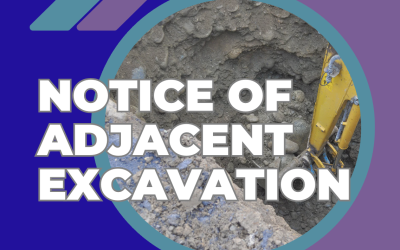In today’s Property Surveying blog post topic we are going to be looking at party wall surveying procedures.
Under the Party Wall etc. Act 1996, upon receipt of a Party Wall Notice served upon them by the building owner, the adjoining owner will have the legal right to dissent and appoint a party wall surveyor.
However, within that right there are two different appointment options. We are now going to take a brief look at these options and shed some light onto the difference between them.
Party Wall Surveyor Appointment Option 1
The first option that an adjoining owner has to them is to dissent and appoint their own party wall surveyor.
The party wall surveyor’s role and duty will be to administer the Party Wall etc. Act 1996 and act wholly on their behalf.
This will result in the building owner also having to appoint their own party wall surveyor.
Those two respective party wall surveyors will then work together to draft, agree and ultimately serve Party Wall Award.
Party Wall Surveyor Appointment Option 2
The second party wall surveyor appointment option that the adjoining owner has open to them, is to dissent and allow for the building owner to share the party wall surveyor with them.
This is legally referred to as an agreed surveyor, and means that the party wall surveyor will act on behalf of both the building owner and adjoining owner jointly.
The single agreed party wall surveyor will progress through the party wall procedures, administering the Act with the ultimate outcome likewise being the agreement of a Party Wall Award.
One of the most common questions we find ourselves asked here at Stokemont on a daily basis, by both building owners and adjoining owners alike, is how a single party wall surveyor can act impartially on behalf of both the building owner and adjoining owner.
More so, because ultimately it is the building owner who has the legal responsibility to cover the party wall surveyor’s reasonable fees and costs.
It is a reasonable question to ask, and is founded on the suspicion, or commercial belief that the party wall surveyor will ultimately favour the party whom is settling their fees and invoice.
Unlike a conventional legal practitioner’s instruction, the party wall surveyor is not acting on behalf of their clients and representing their interests. In a legal scenario, it is not uncommon for solicitors or lawyers to act in the favour and interest of their client. This is where we believe the confusion stems from.
A party wall surveyor’s role is uniquely different. The party wall surveyor is duty bound to act in accordance with the wording of the Party Wall etc. Act 1996. Furthermore, governing body requirements bestow upon the party wall surveyor that they must act impartially and befitting of the works, properties, and risks that are in place.
The best way that we summarise and set this out here at Stokemont is that the party wall surveyor will act on behalf of the properties rather than the owners whom reside within them or who legally own them.
The party wall surveyor’s role as an agreed surveyor can often be a slightly more complicated one, as he or she will be managing two different relationships. One relationship with the building owner, another with the adjoining owner.
Respectively, the party wall surveyor will therefore need to make very clear to both of these respective owners exactly what their duty entails.
In many instances this can involve pointing out to one of the respective owners the requirement to impartiality in administering the Party Wall etc. Act 1996.
Ultimately, an agreed surveyor can only be appointed upon the agreement of the adjoining owner.
While case law does slightly change the tone of this conventional notion, it is still very much the situation whereby if the adjoining owner is more comfortable with the idea of a party wall surveyor acting wholly on their behalf, the building owner will need to comply and ultimately appoint their own party wall surveyor to likewise act on their behalf.
In many cases the party wall surveyor appointed whether that be on behalf of the building owner, adjoining owner, or in an agreed surveyor capacity, should set out to the owners respectively that the difference in appointment and position is relatively narrow and slim.
The party wall surveyor’s duties are still going to include;
- Reviewing the drawings from the perspective of the adjoining owner’s property,
- Looking at any method statements or construction details in respect of the works,
- Undertaking Schedule of Condition reports pre-works,
- Checking off the Schedule of Condition report post-works,
- Agreeing the Party Wall Award,
- Liaising with building owners, adjoining owners, engineers or contractors.
All of these duties would be the same whether the surveyor is acting in an agreed/joint capacity, or alternatively if they are acting on behalf of one of the respective owners.
Our take on agreed surveyor appointments here at Stokemont are that they are not only cost effective for the building owner, they also have the benefit of having cost efficiencies.
This is mainly derived from the fact that the building owner is only responsible for paying a single party wall surveyor’s fee, as opposed to having to pay for two in both a building owner’s party surveyor and adjoining party wall surveyor.
Party wall surveying procedures can be complicated at times, and it is important to note that the Party Wall etc. Act 1996 sets out that anyone, and we do mean anyone, can refer to themselves as a party wall surveyor.
This comes back to the age old advice that selection of the professional who is chosen to serve the initial Party Wall Notices should be made carefully and with due diligence.
An adjoining owner is far more likely to better respond to a Party Wall Notice if it has been prepared by a suitably experienced and naturally qualified surveyor and property professional.
If you would like to discuss party wall surveying procedures with our team of expert party wall surveyors here at Stokemont, please feel free to give us a call today and we will be more than happy to assist and advise you.




